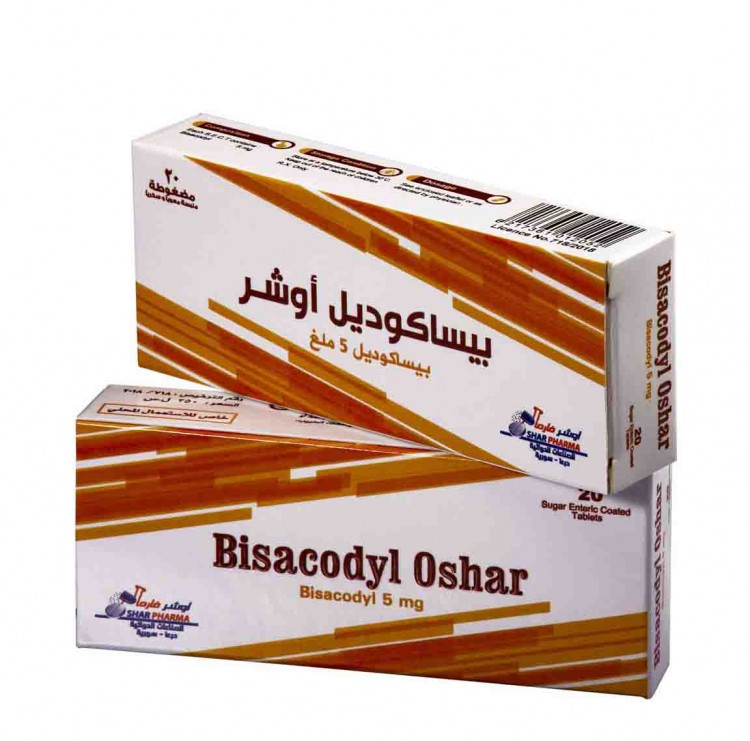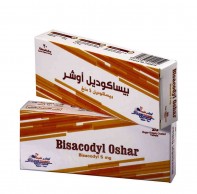BISACODYL OSHAR -5Mg
Composition
Each S.E.C.T contains: 5 mg Bisacodyl.
Excipients : Lactose, Maize starch, Soluble maize starch, Glycerol, Magnesium stearate,Sucrose, Talc, Acacia, Titanium dioxide, Methacrylic acid - methylmethacrylate copolymer (1:1), Methacrylic acid-methylmethacrylate copolymer (1:2), Castor oil, Macrogol 6000, Yellow iron oxide, White beeswax,Carnauba wax, Shellac
Usage
Indications:
Short term relief of constipation.
Constipation either chronic or recent onset, whenever a stimulant laxative is required.
Bowel clearance before surgery, labour or radiological investigation. Replacement of the evacuant enema in all its indications.
Contraindications:
Bisacodyl is contraindicated in patients with ileus, intestinal obstruction, acute abdominal conditions including appendicitis, acute inflammatory bowel diseases, and severe abdominal pain associated with nausea and vomiting which may be indicative of the aforementioned severe conditions.
Bisacodyl is also contraindicated in severe dehydration and in patients with known hypersensitivity to bisacodyl or any other component of the product.
Patients with rare hereditary problems of galactose intolerance, the Lapp lactase deficiency or glucose-galactosemalabsorption should not take this medicine.
Patients with rare hereditary problems of fructose intolerance or sucrase-isomaltase insufficiency should not take this medicine
warnings and precautions :
As with all laxatives, Bisacodyl should not be taken on a continuous daily basis for more than five days without investigating the cause of constipation.
Prolonged and excessive use may lead to fluid and electrolyte imbalance and hypokalaemia.
Intestinal loss of fluids can promote dehydration. Symptoms may include thirst and oliguria. In patients suffering from fluid loss where dehydration may be harmful (e.g. renal insufficiency, elderly patients) Bisacodyl should be discontinued and only be restarted under medical supervision.
Stimulant laxatives including Bisacodyl do not help with weight loss.
Patients may experience haematochezia (blood in stool) that is generally mild and self-limiting.
Dizziness and/or syncope have been reported in patients who have taken Bisacodyl.
There have been isolated reports of abdominal pain and bloody diarrhoea occurring after taking bisacodyl. Some cases have been shown to be associated with colonic mucosal ischaemia.
Bisacodyl should not be taken by children under 10 years without medical advice.
The tablets should not be crushed or chewed but swallowed whole. Antacids should not be given one hour after taking the tablets.
Fertility, pregnancy and lactation:
There are no adequate and well-controlled studies in pregnant women. Long experience has shown no evidence of undesirable or damaging effects during
pregnancy.
Clinical data show that neither the active moiety of bisacodyl nor its glucuronides are excreted into the milk of healthy lactating females.
Nevertheless, as with all medicines, Bisacodyl should not be taken in pregnancy, especially the first trimester, and during breast feeding unless the expected benefit is thought to outweigh any possible risk and only on medical advice.
No studies on the effect on human fertility have been conducted.
Effects on ability to drive and use machines:
No studies on the effects of Bisacodyl on the ability to drive and use
machines have been performed.
However, patients should be advised that due to a vasovagal response (e.g. to abdominal spasm) they may experience dizziness and / or syncope. If patients experience abdominal spasm they should avoid potentially hazardous tasks such as driving or operating machinery.
Side Effects
The most commonly reported adverse reactions during treatment are abdominal pain and diarrhoea.
- Immune system disorders:
Rare: anaphylactic reactions, angioedema, hypersensitivity.
- Metabolism and nutrition disorders:
Rare: dehydration.
- Nervous system disorders:
Uncommon: dizziness.
Rare: Syncope.
- Gastrointestinal disorders:
Uncommon: haematochezia (blood in stool), vomiting, abdominal discomfort, anorectal discomfort.
Common: abdominal cramps, abdominal pain, diarrhoea and nausea.
Rare: colitis including ischaemic colitis.
| Properties |
Pharmacodynamic properties :
Bisacodyl is a locally acting laxative from the diphenylmethane derivatives group having a dual action. bisacodyl stimulates after hydrolysis in the large intestine, the mucosa of both the large intestine and of the rectum. Stimulation of the mucosa of the large intestine results in colonic peristalsis with promotion of accumulation of water, and consequently electrolytes, in the colonic lumen. This results in a stimulation of defecation, reduction of transit time and softening of the stool. Stimulation of the rectum causes increased motility and a feeling of rectal fullness.
Pharmacokinetic properties:
Following either oral or rectal administration, bisacodyl is rapidly hydrolyzed to the active moiety (BHPM), mainly by esterases of the enteric mucosa.
Administration as an enteric coated tablet was found to result in maximum BHPM plasma concentrations between 10 – 4 hours post administration whereas the laxative effect occurred between 12 – 6 hours post administration. In contrast, following the administration as a suppository, the laxative effect occurred on average approximately 20 minutes post administration; in some cases it occurred 45 minutes after administration. The maximum BHPM-plasma concentrations were achieved 3-0.5 hours following the administration as a suppository. Hence, the laxative effect of bisacodyl does not correlate with the plasma level of BHPM. After oral and rectal administration, only small amounts of the drug are absorbed and are almost completely conjugated in the intestinal wall and the liver to form the inactive BHPM glucuronide. The plasma elimination half-life of BHPM glucuronide was estimated to be approximately 16.5 hours. Following the administration of bisacodyl coated tablets, an average of 51.8 % of the dose was recovered in the faeces as free BHPM and an average of 10.5 % of the dose was recovered in the urine as BHPM glucuronide.
|
|---|---|
| Dosage |
- Short term treatment for constipation:
Adults and children over 10 years :
Maximum dosage is 20 mg: 1 to 2 tablets (5 - 10 mg) daily before bedtime.
Children 4 – 10 years:1 tablet (5 mg) daily before bedtime.
It is recommended to start with the lowest dose. The dose may be adjusted up to the maximum recommended dose to produce regular stools.
The maximum daily dose should not be exceeded.
In the management of constipation, once regularity has been restarted dosage should be reduced and can usually be stopped.
Children aged 10 years or younger with chronic or persistent constipation should only be treated under the guidance of a physician. Bisacodyl should not be used in children aged 4 years or younger.
- For preparation of diagnostic procedures and preoperatively:
For preparation of diagnostic procedures, in pre- and postoperative treatment when defaecation needs to be facilitated, Bisacodyl Laxative Tablets should be used under medical supervision. The tablets should be combined with suppositories in order to achieve complete evacuation of the intestine.
Adults and children over 10 years: 2 tablets (10 mg) in the morning and 2 tablets (10 mg) in the evening.
Children aged 4 -10 years of age: 1 tablet (5 mg) in the evening is recommended.
Overdose:
Symptoms: watery stools (diarrhoea), abdominal cramps and a clinically significant loss of fluid, potassium and other electrolytes can occur.
Laxatives when taken in chronic overdose may cause chronic diarrhoea, abdominal pain, hypokalaemia, secondary hyperaldosteronism and renal calculi. Renal tubular damage, metabolic alkalosis and muscle weakness secondary to hypokalaemia have also been described in association with chronic laxative abuse.
Therapy: After ingestion of oral forms of Bisacodyl, absorption can be minimised or prevented by inducing vomiting or gastric lavage. Replacement of fluids and correction of electrolyte imbalance may be required. This is especially important in the elderly and the young. Administration of antispasmodics may be of value.
|
| Drug interactions |
Interaction with other medicinal products:
The concomitant use of antacids and milk products may reduce the resistance of the coating of the tablets and result in dyspepsia and gastric irritation.
The concomitant use of diuretics or adreno-corticosteroids may increase the risk of electrolyte imbalance if excessive doses of Bisacodyl are taken.
Electrolyte imbalance may lead to increased sensitivity to cardiac glycosides.
The concomitant of other laxatives may enhance the gastrointestinal side effects of Bisacodyl.
|
| precautions and precautions |
warnings and precautions :
As with all laxatives, Bisacodyl should not be taken on a continuous daily basis for more than five days without investigating the cause of constipation.
Prolonged and excessive use may lead to fluid and electrolyte imbalance and hypokalaemia.
Intestinal loss of fluids can promote dehydration. Symptoms may include thirst and oliguria. In patients suffering from fluid loss where dehydration may be harmful (e.g. renal insufficiency, elderly patients) Bisacodyl should be discontinued and only be restarted under medical supervision.
Stimulant laxatives including Bisacodyl do not help with weight loss.
Patients may experience haematochezia (blood in stool) that is generally mild and self-limiting.
Dizziness and/or syncope have been reported in patients who have taken Bisacodyl.
There have been isolated reports of abdominal pain and bloody diarrhoea occurring after taking bisacodyl. Some cases have been shown to be associated with colonic mucosal ischaemia.
Bisacodyl should not be taken by children under 10 years without medical advice.
The tablets should not be crushed or chewed but swallowed whole. Antacids should not be given one hour after taking the tablets.
|
| Package |
Storage conditions : Store at a temperature 30 °C.
Packaging : A carton box contains 20 Sugar, Enteric, Coated Tablets .
|


